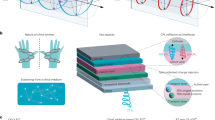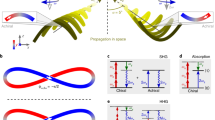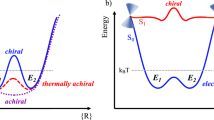Abstract
Circularly polarized light (CPL) emitted from star-forming regions is an attractive candidate as a cause of single chirality in nature. It has remained difficult, however, to translate the relatively small chemical effects observed on irradiation of molecular systems with CPL into high enantiomeric excesses. Here we demonstrate that irradiation of a racemic amino acid derivative with CPL leads to a small amount of chiral induction that can be amplified readily to give an enantiopure solid phase. A racemate composed of equal amounts of left- and right-handed crystals in contact with the irradiated solution is converted completely into crystals of single-handedness through abrasive grinding when racemization is effected in the solution. The rotation sense of the CPL fully determines the handedness of the final solid state. These findings illustrate the potential effectiveness of CPL in the control of molecular asymmetry, which is relevant for the origin of the single chirality inherent to many biological molecules.
This is a preview of subscription content, access via your institution
Access options
Subscribe to this journal
Receive 12 print issues and online access
$259.00 per year
only $21.58 per issue
Buy this article
- Purchase on Springer Link
- Instant access to full article PDF
Prices may be subject to local taxes which are calculated during checkout



Similar content being viewed by others
References
Le Bel, J. A. Sur les relations qui existent entre les formulas atomiques de corps organiques et le pouvior rotatiore de leurs dissolutions. Bull. Soc. Chim. Fr. 22, 337–347 (1874).
Van't Hoff, J. H. Voorstel tot uitbreiding der tegenwoordig in de scheikunde gebruikte structuur-formules in de ruimte: benevens een daarmee samenhangende opmerking omtrent het verband tusschen optisch actief vermogen en chemische constitutie van organische verbindingen. Pamphlet, Utrecht, September 3 (1874).
Bailey, J. et al. Circular polarization in star-formation regions: implications for biomolecular homochirality. Science 281, 672–674 (1998).
Cronin, J. R. & Pizzarello, S. Enantiomeric excesses in meteoritic amino acids. Science 275, 951–955 (1997).
Balavoine, G., Moradpour, A. & Kagan, H. B. Preparation of chiral compounds with high optical purity by irradiation with circularly polarized light, a model reaction for the prebiotic generation of optical activity. J. Am. Chem. Soc. 96, 5152–5158 (1974).
Flores, J. J., Bonner, W. A. & Massey, G. A. Asymmetric photolysis of (RS)-leucine with circularly polarized ultraviolet light. J. Am. Chem. Soc. 99, 3622–3625 (1977).
Huck, N. P. M., Jager, W. F., de Lang, B. & Feringa, B. L. Dynamic control and amplification of molecular chirality by circular polarized light. Science 273, 1686–1688 (1996).
Rikken, G. L. J. A. & Raupach, E. Enantioselective magnetochiral photochemistry. Science 46, 932–935 (2000).
Cave, R. J. Induced chirality with circularly polarized light. Science 323, 1435–1436 (2009).
Barron, L. D. True and false chirality and absolute asymmetric synthesis. J. Am. Chem. Soc. 108, 5539–5542 (1986).
Soai, K., Shibata, T., Morioka, H. & Choji, K. Asymmetric autocatalysis and amplification of enantiomeric excess of a chiral molecule. Nature 378, 767–768 (1995).
Kawasaki, T. et al. Enantioselective synthesis of near enantiopure compound by asymmetric autocatalysis triggered by asymmetric photolysis with circularly polarized light. J. Am. Chem. Soc. 127, 3274–3275 (2005).
Viedma, C. Chiral symmetry breaking during crystallization: complete chiral purity induced by nonlinear autocatalysis and recycling. Phys. Rev. Lett. 94, 065504 (2005).
Noorduin, W. L. et al. Emergence of a single solid chiral state from a nearly racemic amino acid derivative. J. Am. Chem. Soc. 130, 1158–1159 (2008).
Kaptein, B. et al. Attrition-enhanced deracemization of an amino acid derivative that forms an epitaxial racemic conglomerate. Angew. Chem. Int. Ed. 47, 7226–7229 (2008).
Noorduin, W. L. et al. Complete deracemization by attrition-enhanced Ostwald ripening elucidated. Angew. Chem. Int. Ed. 47, 6445–6447 (2008).
Norden, B. Was photoresolution of amino acids the origin of optical activity in life? Nature 226, 566–567 (1977).
Addadi, L. et al. Resolution of conglomerates by stereoselective habit modification. Nature 296, 21–26 (1982).
Weissbuch, I., Addadi, L., Lahav, M. & Leiserowitz, L. Molecular recognition at crystal interfaces. Science 253, 637–645 (1991).
Addadi, L., Weinstein, S., Gati, E., Weissbuch, I. & Lahav, M. Resolution of conglomerates with the assistance of tailor-made impurities. Generality and mechanistic aspects of the ‘rule of reversal’. A new method for assignment of absolute configuration. J. Am. Chem. Soc. 104, 4610–4617 (1982).
Guijarro, A. & Yus, M. Origin of Chirality in the Molecules of Life (RSC, 2008).
Noorduin, W. L. et al. Explanation for the emergence of a single chiral solid state during attrition enhanced Ostwald ripening – survival of the fittest. Cryst. Growth Des. 8, 1675–1681 (2008).
McBride, M. J. & Tully, J. C. Did life grind to a start? Nature 452, 161–162 (2008).
Acknowledgements
The SNN agency (Cooperation Northern Netherlands) and the European Fund for Regional Development (EFRO) are acknowledged for partial financial support of this work. A.J. Toonen is acknowledged for technical assistance. W.L.N acknowledges A.J. Noorduin for stimulating discussions. W.L.N. and E.V. thank COST Action CM0703 for support.
Author information
Authors and Affiliations
Contributions
W.L.N conceived, designed and performed experiments and co-wrote the paper. A.A.C.B. co-designed and performed experiments. M.M. synthesized and analysed compounds and performed nonpolarized light experiments. H.M. co-designed experiments, discussed the results and co-wrote the paper. A.F.E. designed the experimental CPL setup and provided technical assistance. W.J.P.E. and P.C.M.C. discussed the results and commented on the manuscript. B.K., R.M.K., T.R. and E.V. supervised the research and co-wrote the paper.
Corresponding author
Supplementary information
Supplementary information
Supplementary information (PDF 687 kb)
Rights and permissions
About this article
Cite this article
Noorduin, W., Bode, A., van der Meijden, M. et al. Complete chiral symmetry breaking of an amino acid derivative directed by circularly polarized light. Nature Chem 1, 729–732 (2009). https://doi.org/10.1038/nchem.416
Received:
Accepted:
Published:
Issue Date:
DOI: https://doi.org/10.1038/nchem.416
This article is cited by
-
Enantioselectivity of discretized helical supramolecule consisting of achiral cobalt phthalocyanines via chiral-induced spin selectivity effect
Nature Communications (2023)
-
Bioinspired chiral inorganic nanomaterials
Nature Reviews Bioengineering (2023)
-
Circularly Polarized Light-Enabled Chiral Nanomaterials: From Fabrication to Application
Nano-Micro Letters (2023)
-
Self-assembled inorganic chiral superstructures
Nature Reviews Chemistry (2022)
-
Chirality transfer from a 3D macro shape to the molecular level by controlling asymmetric secondary flows
Nature Communications (2022)



